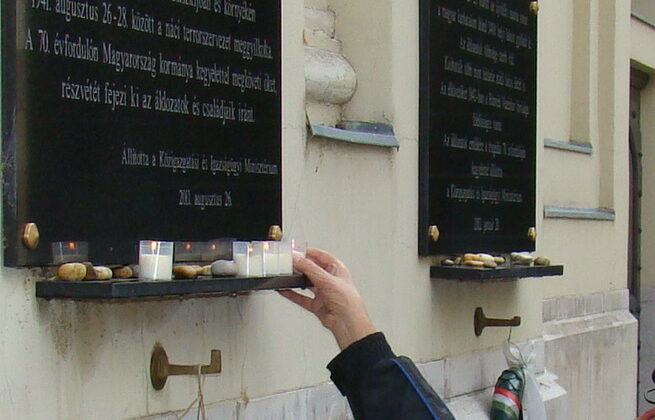The Kamieniec Podolski massacre was commemorated at the Holocaust Memorial Center on August 28, 2013. The opening address of Prof. Dr. Szabolcs Szita, managing director of the Center, was followed by a presentation by Dr. Adam Gellert, LL.M., expert of international law, titled “The 1941 Deportations and the Truth of Zoltan Szirtes”. In the lecture, he reflected upon the newest achievements of the research of the topic and illustrated the efforts of Zoltan Szirtes to shed light on the events and save it from oblivion.
Peter Kirschner, chairman of MAZSIKE, the Hungarian Jewish Cultural Association introduced a joint call by MAZSIKE and the Holocaust Memorial Center to the Hungarian government for marking adequately the site of the events during the 2014 commemorations. Homage to Zoltan Szirtes was paid by short speeches of Eva Gabor, survivor of the deportations and of András Szirtes movie director, son of Zoltan Szirtes. The commemoration was brought to end in the courtyard of the Holocaust Memorial Center, by lighting candles in front of the memorial plaque of the Kőrösmező/ Kamieniec Podolski deportations.
History of the events
Before the German occupation in spring of 1944, the deportations to Kamieniec Podolski were the bloodiest atrocity committed against Jews in Hungary. Some 20,000 Jews, declared as “stateless” and collected by KEOKH, the Central National Authority for Controlling Foreigners, were transferred first to Kőrösmező, and then deported to the part of Galicia under Hungarian military control. (Many of the victims were actually collected at the site of the commemoration, the synagogue in the Páva Street that served as internment facility at that time.) The German units massacred the innocent victims near Kamieniec Podolski on August 27-29, 1941. The number of murdered is estimated to 11,000, but efforts towards a detailed historical research are still to be made.
Zoltán Szirtes (1916 – 1997)
Zoltán Szirtes played a groundbreaking role in making the 1941 deportations part of Hungarian collective remembrance. At the beginning of 1990’s, he was the author and driving force of the initiative that aimed at compelling the Hungarian state to accept, at least indirectly, its responsibility in the events. He was a passionate seeker of the truth, working persistently on discovering the events. He has published the results of his research, his struggle with the authorities and experiences gained in half-decade long efforts with the title “Our Unburied Dead”. The commemoration event was simultaneously a homage paid also to his forgotten, devoted and exemplary activities.
